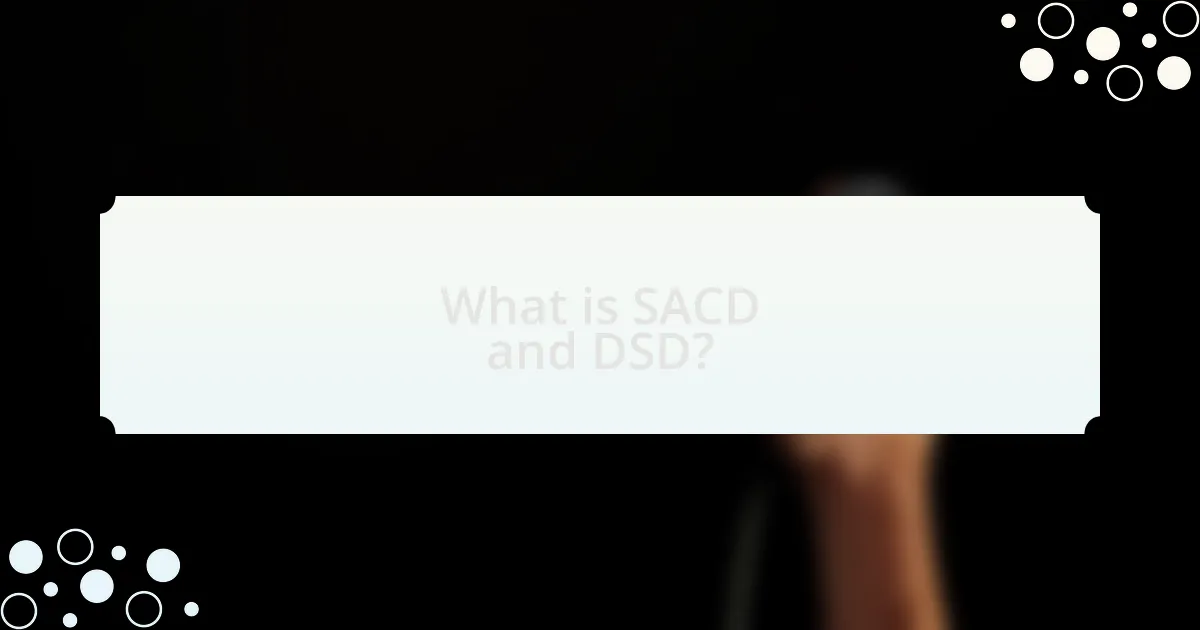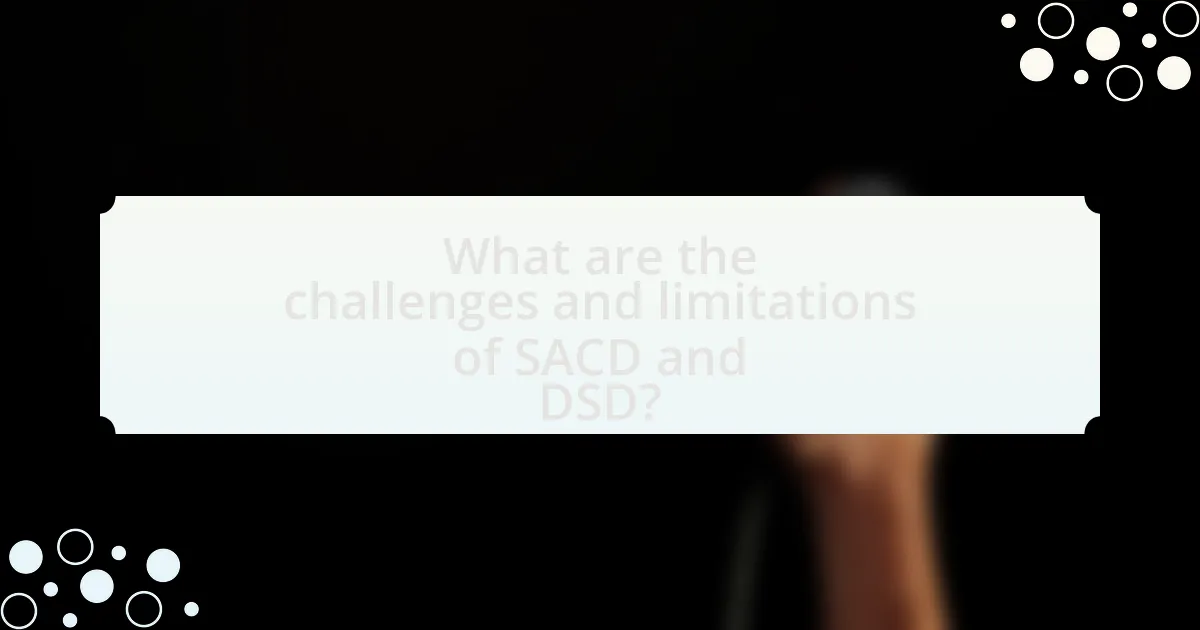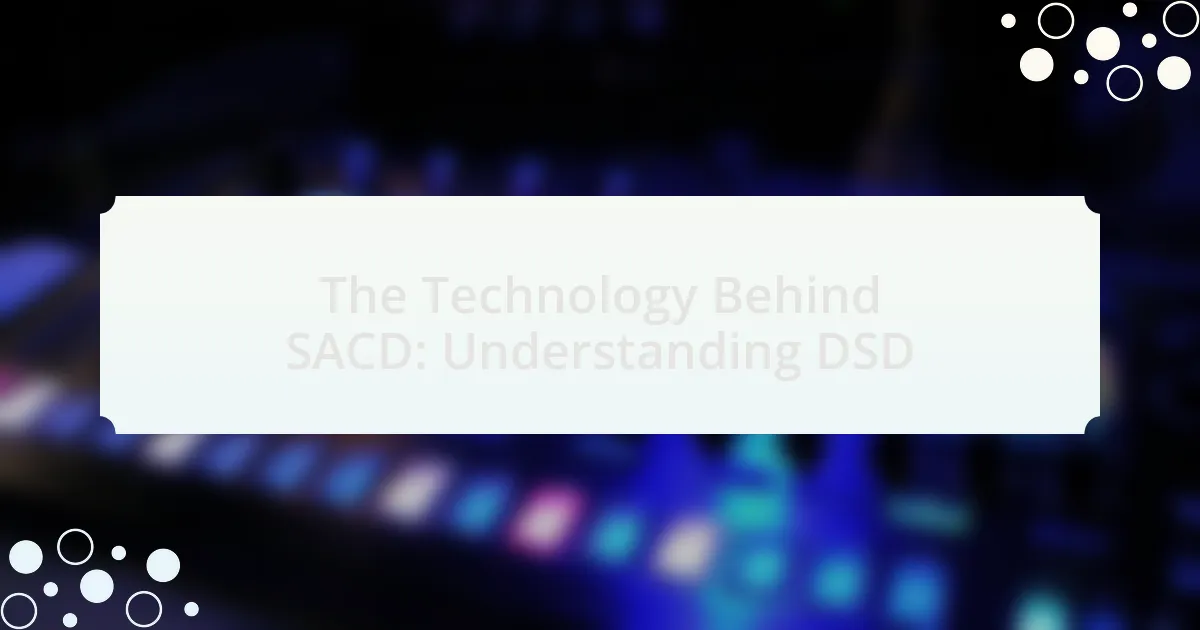SACD, or Super Audio CD, is a high-resolution audio format that employs Direct Stream Digital (DSD) technology for superior sound reproduction. This article explores the relationship between SACD and DSD, detailing the history, key features, and advantages of these technologies. It also examines the technical specifications of DSD, the playback requirements, and the challenges users face, such as compatibility issues and file size limitations. Additionally, the article discusses future developments in SACD and DSD technology, innovations in DSD, and practical tips for optimizing the audio experience with these formats.
What is SACD and DSD?

SACD, or Super Audio CD, is a high-resolution audio format that utilizes Direct Stream Digital (DSD) technology for sound reproduction. DSD encodes audio using a 1-bit sigma-delta modulation process, which allows for a higher sampling rate compared to traditional PCM formats, resulting in improved audio fidelity. SACD was developed by Sony and Philips in the early 2000s to provide a superior listening experience, supporting multi-channel audio and higher dynamic range. The DSD format is characterized by its ability to capture audio with greater detail and nuance, making it a preferred choice for audiophiles and music producers seeking high-quality sound.
How do SACD and DSD relate to each other?
SACD, or Super Audio CD, utilizes DSD, which stands for Direct Stream Digital, as its audio encoding format. DSD is a method of digital audio encoding that captures sound in a high-resolution format, allowing SACD to deliver superior audio quality compared to standard CDs. The relationship is foundational, as SACD discs are specifically designed to store and play back audio encoded in DSD, enabling the high-fidelity sound experience that SACD is known for.
What is the history behind SACD and DSD technology?
SACD (Super Audio CD) and DSD (Direct Stream Digital) technology originated in the late 1990s, developed by Sony and Philips as a high-resolution audio format. The introduction of SACD in 1999 aimed to provide superior sound quality compared to traditional CDs, utilizing DSD encoding, which captures audio in a one-bit format at a high sampling rate of 2.8224 MHz. This approach allows for a more accurate representation of analog sound waves. The technology was designed to appeal to audiophiles and enhance the listening experience, leading to the release of numerous SACD titles across various music genres. The adoption of SACD and DSD has influenced the development of other high-resolution audio formats, solidifying their place in the evolution of digital audio technology.
What are the key features of SACD and DSD?
SACD (Super Audio CD) and DSD (Direct Stream Digital) are key technologies in high-resolution audio. SACD offers multi-channel audio capabilities, allowing for immersive sound experiences, while DSD utilizes a 1-bit audio encoding system that captures audio with a high sampling rate of 2.8224 MHz, significantly surpassing standard CD audio quality. This combination results in superior sound fidelity and dynamic range, making SACD and DSD popular among audiophiles. The DSD format’s low noise and high resolution contribute to its ability to reproduce audio with remarkable clarity and detail, further validating its effectiveness in high-end audio applications.
What are the advantages of using SACD and DSD?
The advantages of using SACD (Super Audio CD) and DSD (Direct Stream Digital) include superior audio quality and enhanced dynamic range. SACD utilizes a higher sampling rate and bit depth compared to standard CDs, allowing for more accurate sound reproduction. DSD, the encoding format used in SACD, captures audio in a way that closely resembles analog sound, resulting in a more natural listening experience. Studies have shown that listeners often perceive SACD and DSD recordings as having greater clarity and detail, which is supported by the technology’s ability to reproduce frequencies beyond the range of standard CDs.
How does DSD improve audio quality compared to other formats?
DSD, or Direct Stream Digital, improves audio quality compared to other formats by utilizing a 1-bit sigma-delta modulation process that captures audio at a much higher sampling rate, typically 2.8 MHz or 5.6 MHz, which allows for greater detail and a more accurate representation of sound. This high sampling rate reduces quantization noise and enhances the dynamic range, resulting in clearer and more natural audio reproduction. Studies have shown that listeners often perceive DSD recordings as more lifelike and engaging than those produced in PCM (Pulse Code Modulation) formats, which typically operate at lower sampling rates and bit depths.
What are the benefits of SACD for music enthusiasts?
SACD, or Super Audio CD, offers several benefits for music enthusiasts, primarily through its high-resolution audio quality. This format utilizes Direct Stream Digital (DSD) technology, which captures audio at a much higher sampling rate than standard CDs, resulting in a more accurate and detailed sound reproduction. The DSD format operates at 2.8224 MHz, significantly surpassing the 44.1 kHz of traditional CDs, allowing for a broader frequency range and improved dynamic range. Additionally, SACDs can include multi-channel audio, providing an immersive listening experience that enhances the spatial quality of music. These features make SACD a preferred choice for audiophiles seeking superior sound fidelity and a richer musical experience.
How does DSD technology work?

DSD technology, or Direct Stream Digital, works by encoding audio signals using a one-bit delta-sigma modulation process. This method samples audio at a very high frequency, typically 2.8224 MHz for standard DSD, which is 64 times the CD audio sampling rate of 44.1 kHz. The one-bit data stream represents changes in audio amplitude, allowing for a more accurate reproduction of sound waves compared to traditional PCM (Pulse Code Modulation) methods. DSD’s high sampling rate and low quantization noise contribute to its ability to capture subtle nuances in music, making it a preferred format for high-fidelity audio applications.
What is the process of Direct Stream Digital encoding?
Direct Stream Digital (DSD) encoding is a method of digital audio encoding that uses a 1-bit delta-sigma modulation technique to represent audio signals. In this process, the audio waveform is sampled at a very high frequency, typically 2.8224 MHz for standard DSD, which is 64 times the CD audio sampling rate. The audio signal is converted into a stream of 1s and 0s, where each bit represents a change in the audio signal’s amplitude, allowing for a high level of detail and dynamic range in the recorded sound. This encoding method is utilized in Super Audio CDs (SACDs) and is known for its ability to produce high-fidelity audio reproduction, making it a preferred choice for audiophiles.
How does the DSD encoding process differ from PCM?
The DSD encoding process differs from PCM in that DSD uses a one-bit delta-sigma modulation technique, while PCM employs multi-bit pulse code modulation. DSD encodes audio by sampling at a high frequency, typically 2.8 MHz or higher, and represents audio signals as a series of 1s and 0s, capturing changes in amplitude over time. In contrast, PCM captures audio by sampling at lower frequencies, such as 44.1 kHz or 96 kHz, and quantizes the amplitude into discrete levels, resulting in a more complex data structure. This fundamental difference in encoding leads to variations in sound quality and dynamic range, with DSD often being praised for its smoother sound and greater fidelity in high-frequency reproduction.
What are the technical specifications of DSD audio?
DSD audio, or Direct Stream Digital audio, is characterized by its use of a 1-bit sigma-delta modulation process at sample rates of 2.8224 MHz (DSD64), 5.6448 MHz (DSD128), and 11.2896 MHz (DSD256). This high-frequency sampling allows for a dynamic range of up to 120 dB and a frequency response that can extend beyond 100 kHz, making it suitable for high-resolution audio applications. The DSD format is primarily used in Super Audio CDs (SACDs) and is designed to provide a more natural sound reproduction compared to traditional PCM formats.
What are the playback requirements for DSD audio?
DSD audio playback requires a compatible digital-to-analog converter (DAC) that supports DSD formats, as well as software capable of processing DSD files. DSD, or Direct Stream Digital, uses a 1-bit audio signal at a high sampling rate, typically 2.8 MHz or 5.6 MHz, necessitating specific hardware and software for accurate playback. Many modern DACs and media players are designed to handle DSD audio, ensuring high fidelity and quality reproduction.
What types of equipment are needed to play DSD files?
To play DSD files, a digital-to-analog converter (DAC) that supports DSD format is essential. DSD files require specific hardware capable of decoding the high-resolution audio format, which is typically found in high-end audio equipment. Additionally, a compatible media player or software that can handle DSD playback is necessary, as well as a suitable audio system, such as speakers or headphones, to reproduce the sound accurately. These components ensure that the unique characteristics of DSD audio are preserved and delivered effectively.
How does DSD playback affect sound quality?
DSD playback significantly enhances sound quality by providing a higher sampling rate and bit depth compared to traditional PCM formats. This high-resolution audio format captures more detail and nuance in the sound, resulting in a more accurate and immersive listening experience. Studies have shown that DSD’s 1-bit encoding at rates like 2.8 MHz or 5.6 MHz allows for a smoother representation of audio waveforms, reducing quantization noise and improving dynamic range. Consequently, listeners often report a more natural and lifelike sound, making DSD playback a preferred choice for audiophiles seeking superior audio fidelity.
What are the challenges and limitations of SACD and DSD?

The challenges and limitations of SACD (Super Audio CD) and DSD (Direct Stream Digital) include compatibility issues, limited software support, and high production costs. SACD players are not universally compatible with standard CD players, which restricts the audience for SACD discs. Additionally, DSD files are not widely supported by mainstream audio software and devices, making it difficult for consumers to access and play these formats. The production of SACD and DSD content is often more expensive than traditional formats due to the specialized equipment and expertise required, which can limit the availability of new releases. These factors collectively hinder the widespread adoption and use of SACD and DSD in the audio market.
What are the common issues faced by users of SACD and DSD?
Common issues faced by users of SACD and DSD include compatibility problems, limited playback options, and high storage requirements. Users often encounter difficulties when trying to play SACD discs on standard CD players, as SACD requires specific hardware to decode its format. Additionally, DSD files can be challenging to manage due to their large file sizes, which necessitate significant storage capacity and can complicate file transfer and playback on various devices. Furthermore, not all audio equipment supports DSD playback, leading to frustration among users who invest in high-resolution audio systems. These issues highlight the need for compatible hardware and sufficient storage solutions for optimal user experience with SACD and DSD formats.
How can users troubleshoot playback problems with DSD?
Users can troubleshoot playback problems with DSD by checking their playback software and hardware compatibility. Ensuring that the software supports DSD formats, such as DSD64 or DSD128, is crucial, as not all players handle these formats. Additionally, users should verify that their digital-to-analog converter (DAC) is DSD-capable, as many DACs require specific settings or firmware updates to process DSD signals correctly. If playback issues persist, users can also try different USB cables or ports, as poor connections can lead to data loss during transmission. Lastly, consulting the user manuals for both the playback software and hardware can provide specific troubleshooting steps tailored to the devices in use.
What are the limitations of DSD in terms of file size and compatibility?
DSD, or Direct Stream Digital, has limitations regarding file size and compatibility. The file size of DSD recordings can be significantly larger than PCM formats, as DSD uses a 1-bit encoding at a high sampling rate, resulting in larger files that require more storage space. For example, a standard DSD file can be approximately 2.8 MB per minute for stereo audio, which can quickly accumulate for longer recordings.
In terms of compatibility, DSD is not universally supported across all audio playback devices and software. Many standard audio players and systems are designed for PCM formats, limiting the ability to play DSD files without specialized hardware or software. Additionally, some streaming services do not support DSD, further restricting its accessibility. These factors contribute to the challenges users face when working with DSD files in various environments.
What future developments can we expect for SACD and DSD technology?
Future developments for SACD and DSD technology include advancements in high-resolution audio formats and increased integration with streaming services. As consumer demand for superior audio quality rises, manufacturers are likely to enhance SACD players and DSD encoding techniques to support higher bit rates and sampling frequencies. Additionally, the growing trend of digital music consumption may lead to more software and hardware solutions that facilitate DSD playback, making it more accessible to a broader audience. The ongoing evolution of digital audio technology, including improvements in digital-to-analog converters (DACs) and audio processing algorithms, will further enhance the listening experience associated with SACD and DSD formats.
How is the industry evolving in terms of high-resolution audio formats?
The industry is evolving towards greater adoption and accessibility of high-resolution audio formats, driven by advancements in technology and consumer demand for superior sound quality. Streaming services like Tidal and Qobuz now offer high-resolution audio options, making it easier for consumers to access these formats. Additionally, hardware manufacturers are increasingly producing devices that support high-resolution playback, such as DACs and headphones, which enhances the listening experience. The growth of digital downloads and the rise of formats like DSD (Direct Stream Digital) further illustrate this trend, as they provide higher fidelity compared to traditional formats. According to a report by the International Federation of the Phonographic Industry, the global market for high-resolution audio is expected to grow significantly, reflecting a shift in consumer preferences towards premium audio experiences.
What innovations are being explored in DSD technology?
Innovations being explored in DSD technology include higher bit rates and advanced noise shaping techniques. These advancements aim to enhance audio fidelity and reduce distortion, making DSD recordings more appealing to audiophiles. Research indicates that increasing the bit rate can improve the dynamic range and overall sound quality, while new noise shaping methods can optimize the signal-to-noise ratio, resulting in clearer audio reproduction.
What practical tips can enhance the SACD and DSD experience?
To enhance the SACD and DSD experience, use high-quality playback equipment that supports these formats, as the fidelity of the sound is significantly influenced by the hardware. Investing in a dedicated SACD player or a high-resolution digital-to-analog converter (DAC) ensures optimal audio performance, as these devices are designed to handle the specific requirements of DSD audio. Additionally, utilizing high-quality cables and connectors can minimize signal loss and interference, further improving sound quality. Properly setting up your listening environment, including speaker placement and room acoustics, also contributes to a more immersive audio experience.
How can users optimize their audio setup for SACD and DSD playback?
Users can optimize their audio setup for SACD and DSD playback by ensuring they have a compatible SACD player and high-quality digital-to-analog converters (DACs) that support DSD formats. A dedicated SACD player is essential as it can read the hybrid discs that contain both standard CD and SACD layers, while high-quality DACs enhance audio fidelity by accurately converting DSD signals into analog sound. Additionally, using balanced connections and high-quality cables can minimize signal loss and interference, further improving sound quality. Proper speaker placement and room acoustics also play a crucial role in achieving optimal playback performance, as they can significantly affect soundstage and clarity.
What are the best practices for storing and managing DSD files?
The best practices for storing and managing DSD files include using high-capacity storage solutions, maintaining file integrity through regular backups, and organizing files with a clear naming convention. High-capacity storage solutions, such as NAS (Network Attached Storage) or external hard drives, are essential due to the large file sizes associated with DSD formats. Regular backups ensure that data is not lost due to hardware failure or accidental deletion, while a clear naming convention helps in easily locating and identifying files. Additionally, using software that supports DSD playback and management can enhance the user experience and ensure compatibility with various devices.

Leave a Reply